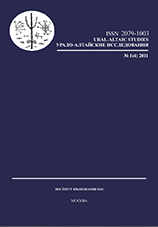Yakut elements of Mongolic origin in Evenki
Yakut elements of Mongolic origin in Evenki
Author(s): Bayarma Khabtagaeva-KempfSubject(s): Language and Literature Studies
Published by: Институт языкознания Российской академии наук
Keywords: Evenki language; Yakut language; Mongolian languages; comparative linguistics; chronology of language contacts
Summary/Abstract: In this paper, I have proposed some phonological, morphological and semantic criteria which characterize Yakut elements of Mongolic origin in Evenki. On the basis of these criteria, it is possible to distinguish between direct borrowings from Mongolic and indirect borrowings via Yakut language. In spite of the fact that Evenki dialects in Yakutia and the Barguzin Evenki dialect in Buryatia belong to the eastern group of Evenki dialects, the phonetic features of their Mongolic elements demonstrate that the Mongolic sources of the two loanword groups and the periods of borrowing were different. The Mongolic elements of the Evenki dialects borrowed via Yakut belong to the early period, but they do not show “daguroid” peculiarities, e.g.: — the absence of the Middle Mongolic initial h-, which is typical for direct borrowings; — the development of a long vowel in place of the Mongolic VgV sequence according to the Yakut phonetic rules, while the sequence is preserved in direct borrowings; — in most cases the regressive assimilation of the Mongolic vowel i has not yet occurred in both groups of borrowings; — the preservation of the Mongolic initial consonants č- and ǰ- in both groups of borrowings; — the Mongolic sequence si has not developed into ši. Accordingly, at least two different Mongolic languages must be presumed to have existed in the Baikal region, where intensive linguistic contacts among the Turkic, Tungusic and Mongolic tribes took place.
Journal: Урало-алтайские исследования
- Issue Year: 2011
- Issue No: 01 (4)
- Page Range: 93-109
- Page Count: 17
- Language: English

